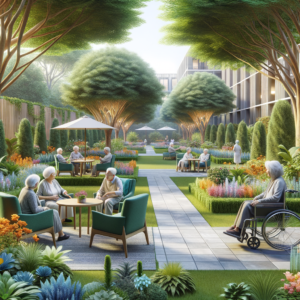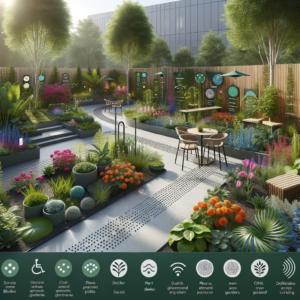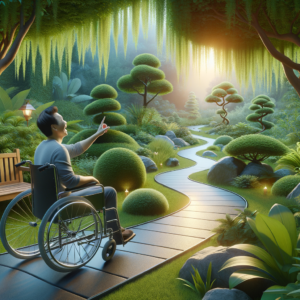Sensory gardens offer a unique and enriching experience for all gardeners, but they hold special significance for those with visual impairments. By focusing on non-visual senses, these gardens create an immersive environment that can be fully appreciated through touch, smell, sound, and even taste. This comprehensive guide will explore how to design, create, and maintain sensory gardens that cater specifically to visually impaired gardeners, ensuring an accessible and enjoyable outdoor experience.
Understanding Sensory Gardens
Sensory gardens are designed to stimulate all five senses, with a particular emphasis on non-visual elements:
- Touch: Varied textures in plants and landscaping materials
- Smell: Aromatic plants and flowers
- Sound: Water features, wind chimes, and rustling plants
- Taste: Edible plants and herbs
- Sight: For those with partial vision, high-contrast colors and bold shapes
For visually impaired gardeners, these elements become even more crucial in creating an engaging and navigable garden space.
Key Elements of a Sensory Garden for the Visually Impaired
- Textured Pathways: Use different materials to indicate various garden areas
- Raised Beds: Bring plants within easy reach
- Scented Plants: Strategically placed for aromatic wayfinding
- Sound Elements: Water features, wind chimes, and bird feeders
- Tactile Signs: Braille or raised letter signage for plant identification
- Handrails: For guidance and support along paths
- Distinct Garden Rooms: Create separate areas with unique sensory experiences
Plant Selection for Tactile and Olfactory Stimulation
Tactile Plants:
- Lamb’s Ear (Stachys byzantina): Soft, velvety leaves
- Succulents: Various textures and shapes
- Ornamental Grasses: Different textures and movement in the wind
- Ferns: Delicate, feathery fronds
- Bark of trees: Cork bark elm or paper bark maple for interesting textures
Aromatic Plants:
- Herbs: Rosemary, lavender, mint, basil
- Scented Geraniums: Various fragrances including lemon, rose, and chocolate
- Roses: Choose highly fragrant varieties
- Lilacs: Strong, sweet scent in spring
- Honeysuckle: Sweet fragrance and edible nectar
Incorporating Sound Elements
- Water Features: Fountains, small waterfalls, or bubbling streams
- Wind Chimes: Various materials for different tones
- Rustling Plants: Bamboo, ornamental grasses, or aspen trees
- Bird Attractants: Feeders and bird-friendly plants to encourage avian visitors
- Musical Elements: Outdoor percussion instruments or wind harps
Taste: Edible Plants in Sensory Gardens
- Herb Garden: Basil, thyme, oregano, chives
- Fruit Trees: Dwarf varieties of apple, pear, or cherry
- Berry Bushes: Raspberries, blueberries, or strawberries
- Vegetable Patch: Cherry tomatoes, snap peas, or carrots
- Edible Flowers: Nasturtiums, pansies, or borage
Creating Safe and Navigable Spaces
- Clear Pathways: Wide, level paths with defined edges
- Consistent Layout: Maintain a logical and memorable garden layout
- Tactile Markers: Use different textures to mark path intersections or changes
- Remove Hazards: Ensure paths are free from obstacles and overhanging plants
- Adequate Lighting: For those with partial vision, provide well-lit areas
Raised Beds and Vertical Gardening for Accessibility
- Raised Beds:
- Height: 24-36 inches for easy reach
- Width: No more than 3 feet for access from one side, 4 feet if accessible from both sides
- Vertical Gardens:
- Wall-mounted planters
- Trellises for climbing plants
- Hanging baskets at various heights
Labeling and Information Access
- Braille Labels: Include plant names and basic information
- Large Print Signs: High contrast for those with partial vision
- QR Codes: Link to audio descriptions or more detailed plant information
- Tactile Maps: Create a 3D map of the garden layout
- Audio Guides: Provide recorded tours or plant descriptions
Seasonal Considerations
- Year-Round Interest: Plan for sensory experiences in all seasons
- Winter Textures: Incorporate plants with interesting bark or seed heads
- Spring Scents: Focus on fragrant spring bloomers
- Summer Sounds: Maximize rustling leaves and grasses
- Fall Flavors: Include plants with edible autumn fruits or leaves
Therapeutic Benefits
- Stress Reduction: Sensory engagement promotes relaxation
- Physical Activity: Gardening provides gentle exercise
- Cognitive Stimulation: Learning about plants and garden layout
- Emotional Well-being: Sense of achievement and connection with nature
- Social Interaction: Opportunities for shared experiences and learning
Community Involvement and Social Aspects
- Garden Clubs: Form or join clubs specifically for visually impaired gardeners
- Workshops: Organize sensory gardening workshops and plant identification classes
- Community Gardens: Create dedicated sensory sections in community spaces
- Volunteer Programs: Engage sighted volunteers to assist with maintenance and guided tours
- Sensory Garden Events: Host events to raise awareness and share experiences
Maintenance Tips
- Regular Pruning: Keep paths clear of overhanging plants
- Prompt Repairs: Address any path or structure issues immediately
- Plant Health: Monitor for pests and diseases to maintain plant vitality
- Seasonal Clean-up: Remove fallen leaves and maintain clear pathways
- Updating Sensory Elements: Refresh scents, sounds, and textures periodically
Conclusion
Designing sensory gardens for visually impaired gardeners opens up a world of rich, immersive experiences in nature. By thoughtfully incorporating elements that stimulate all the senses, with a focus on touch, smell, sound, and taste, these gardens become accessible, enjoyable, and therapeutic spaces. Remember that the key to a successful sensory garden lies in its ability to engage, surprise, and delight through non-visual means.
Creating such a garden not only provides a wonderful outdoor experience for visually impaired individuals but also enhances the gardening experience for all visitors, encouraging a deeper, more mindful interaction with nature. Through careful planning, appropriate plant selection, and attention to accessibility and safety, you can create a sensory garden that offers year-round enjoyment, learning opportunities, and a strong connection to the natural world.
FAQ
- Q: How large does a sensory garden need to be? A: Sensory gardens can be any size, from a small patio to a large outdoor space. Even a few square feet can provide a rich sensory experience.
- Q: Are there any plants that should be avoided in a garden for visually impaired individuals? A: Avoid plants with thorns, sharp edges, or toxic properties. Also, be cautious with plants that can cause strong allergic reactions.
- Q: How can I make plant identification easier for visually impaired gardeners? A: Use a combination of Braille labels, large print signs, and audio guides. Consider creating a tactile reference guide with leaf shapes and textures.
- Q: What are some low-maintenance options for sensory gardens? A: Choose native plants adapted to your climate, use mulch to reduce weeding, and incorporate perennials and shrubs that don’t require frequent care.
- Q: Can sensory gardens be enjoyed by people without visual impairments? A: Absolutely! Sensory gardens enhance the experience for all visitors by encouraging a more immersive and mindful interaction with nature.



